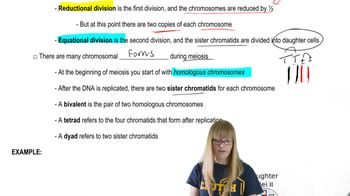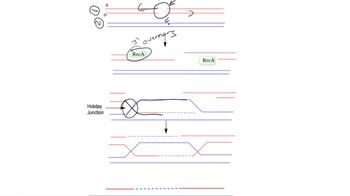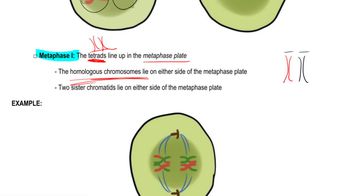Table of contents
- 1. Introduction to Genetics51m
- 2. Mendel's Laws of Inheritance3h 37m
- 3. Extensions to Mendelian Inheritance2h 41m
- 4. Genetic Mapping and Linkage2h 28m
- 5. Genetics of Bacteria and Viruses1h 21m
- 6. Chromosomal Variation1h 48m
- 7. DNA and Chromosome Structure56m
- 8. DNA Replication1h 10m
- 9. Mitosis and Meiosis1h 34m
- 10. Transcription1h 0m
- 11. Translation58m
- 12. Gene Regulation in Prokaryotes1h 19m
- 13. Gene Regulation in Eukaryotes44m
- 14. Genetic Control of Development44m
- 15. Genomes and Genomics1h 50m
- 16. Transposable Elements47m
- 17. Mutation, Repair, and Recombination1h 6m
- 18. Molecular Genetic Tools19m
- 19. Cancer Genetics29m
- 20. Quantitative Genetics1h 26m
- 21. Population Genetics50m
- 22. Evolutionary Genetics29m
9. Mitosis and Meiosis
Meiosis
Problem 12a
Textbook Question
Given the end results of the two types of division, why is it necessary for homologs to pair during meiosis and not desirable for them to pair during mitosis?
 Verified step by step guidance
Verified step by step guidance1
Understand the purpose of mitosis and meiosis: Mitosis is for growth and repair, producing identical cells, while meiosis is for sexual reproduction, producing genetically diverse gametes.
Recognize that homologous chromosomes are pairs of chromosomes, one from each parent, that are similar in shape, size, and genetic content.
In meiosis, homologous chromosomes pair up during prophase I to allow for crossing over, which increases genetic diversity in the resulting gametes.
During mitosis, pairing of homologous chromosomes is not necessary because the goal is to produce identical daughter cells, not to increase genetic diversity.
If homologous chromosomes paired during mitosis, it could lead to errors in chromosome number or structure, disrupting the production of identical cells.
Recommended similar problem, with video answer:
 Verified Solution
Verified SolutionThis video solution was recommended by our tutors as helpful for the problem above
Video duration:
2mPlay a video:
Was this helpful?
Key Concepts
Here are the essential concepts you must grasp in order to answer the question correctly.
Meiosis vs. Mitosis
Meiosis and mitosis are two types of cell division. Mitosis results in two identical daughter cells, maintaining the same chromosome number as the parent cell, while meiosis produces four genetically diverse gametes with half the chromosome number. Understanding the distinct purposes of these processes is crucial for grasping why homologous chromosomes behave differently during each.
Recommended video:
Guided course

Meiosis Overview
Homologous Chromosomes
Homologous chromosomes are pairs of chromosomes, one inherited from each parent, that have the same genes but may carry different alleles. During meiosis, pairing of homologs is essential for genetic recombination and proper segregation, ensuring genetic diversity. In contrast, pairing during mitosis could lead to genetic imbalances in daughter cells.
Recommended video:
Guided course

Chromosome Structure
Genetic Recombination
Genetic recombination occurs during meiosis when homologous chromosomes exchange genetic material, leading to new allele combinations in gametes. This process is vital for evolution and adaptation, as it increases genetic variation. In mitosis, recombination is not necessary and could disrupt the genetic integrity of the resulting cells, making it undesirable.
Recommended video:
Guided course

Recombination after Double Strand Breaks

 5:30m
5:30mWatch next
Master Meiosis Overview with a bite sized video explanation from Kylia Goodner
Start learningRelated Videos
Related Practice


